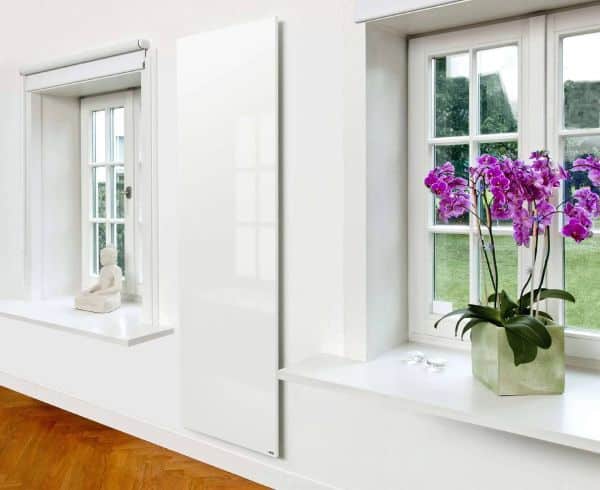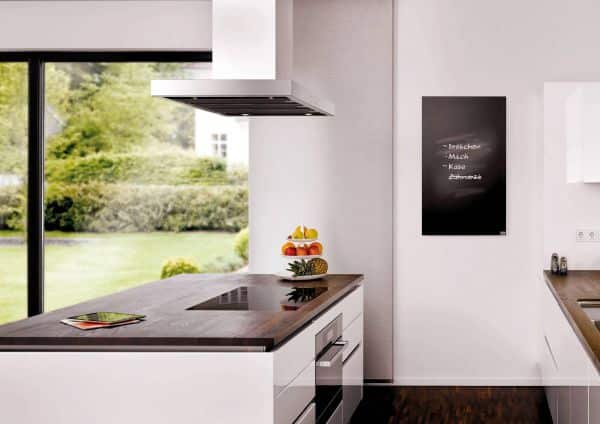How good are infrared heaters?

Infrared heaters are an exciting alternative to classic heaters. But what is actually special about these heaters, what about the costs and the climate balance and which providers are there?
What are infrared heaters?
Infrared heaters are a form of electric heaters. Unlike radiant heaters, infrared heaters do not pose a risk of burns – the surface temperature of the wall radiators is 80 to 95 degrees Celsius. However, when mounting a wall, you should keep a safety distance of at least 20 to 30 centimetres from flammable materials to avoid overheating furniture. If you are planning to install a ceiling, a clear height of 2.50 metres is recommended in order to achieve the most even heat distribution possible.
Compared to classic radiators or underfloor heating, infrared heaters are characterised above all by their high flexibility. The laying of pipes is not necessary with this form of heating. Instead, many models can simply be plugged into a power outlet.
How does an infrared heater work?
An infrared heater usually consists of a solid panel connected to a heating conductor that converts electrical energy into heat (the infrared panel). The heatingsystem emits infrared radiation, which directly heats the walls or furniture. This is because theyabsorb the radiant heat, store it and release it again later. This distinguishes infrared heaters from conventional heaters, which heat the air in the room. The infrared rays are comparable to the sun's rays that warm up your apartment or house.
The heat spread by an infrared heater is correspondingly pleasant . The practical thing about this is that the heat is emitted evenly through the so-called radiation exchange.
How long does an infrared heater take to heat the room?
Infrared heating starts heating a room immediately after it is switched on. It takes 30 minutes to a few hours for it to heat up completely. The specific time depends on the size of the room, the power of the heating panels and the insulation of the room.
You can easily control your infrared heating via a wireless thermostat, conveniently by remote control. Some models can also be connected to Wi-Fi and controlled via the Smart Home app on your tablet or smartphone.
By the way: The infrared rays are invisible and harmless to us.
Installing your infrared heater
Installing an infrared heater is very easy, as you simply plug it into the socket. For mounting on the wall or ceiling, appropriate brackets and assembly instructions are often included in the scope of delivery. This means that you can carry out installation and commissioning yourself and are not dependent on a heating installer.
Where is the best place for an infrared heater?
Infrared heaters are usually available as individual radiators that are mounted on the wall or ceiling. In addition, the models differ mainly in terms of surface material. They are available, for example, with a front made of:
- Metal
- Glass
- Mirror surface
- Picture (motif or own photo)
- Natural stone
- Slate (can be written on as a tablet)
They are also available as a stand-alone unit or as a permanently installed heating system (surface heating):
- Wall heating
- Ceiling heating
- Underfloor heating
Infrared heaters are powered by electricity and provide heat at the touch of a button.
Advantages and disadvantages of infrared heaters
Advantages
In addition to the central advantage of high flexibility, infrared heaters are characterized by other properties:
- They provide particularly pleasant room warmth and do not dry out the air.
- They do not cause any air turbulence – the indoor climate is much more pleasant, especially for house dust allergy sufferers.
- Infrared heaters are easily controlled via a thermostat or via a smart home app.
- They are ready for use within a few seconds.
- They are easy and inexpensive to install.
- They are extremely flat and therefore space-saving and can be easily attached to the wall or ceiling. All you need is a power outlet.
By the way, there are also infrared heaters that can be integrated inconspicuously and harmoniously into the furnishings of your apartment or house. For example, there are variants in the form of a mirror or a blackboard.
Disadvantages
Unlike conventional heaters, infrared heating is powered by electricity. And that brings with it the biggest disadvantage:
- The electricity consumption causes correspondingly high electricity costs.
- The carbon footprint of infrared heating depends heavily on whether you use conventional electricity or green electricity. CO2 emissions are correspondingly higher with conventional electricity.
- If you want to use infrared heating throughout the house, the acquisition costs are correspondingly high.
- In principle, we recommend that you only use electric heaters as a temporary supplement so as not to overload the power grid, especially in winter.
How much does an infrared heater cost?
The prices for infrared heaters are initially based on the heating capacity. You can get radiators with 180 to 200 watts for as little as 100 to 300 euros. Large infrared heaters, which deliver between 900 and 1,200 watts, cost between approx. 200 to 600 euros. Prices are for metal radiators; you usually have to pay a surcharge for picture and other special designs. How the required heating capacity is calculated depends primarily on the size of the respective room, the building fabric of the house or apartment and the desired temperature. In case of doubt, it can't hurt to get the opinion of an expert at this point.
Infrared heating: How many watts per square metre?
How much an infrared heater costs in total also depends on the size of the room. You need a heating capacity of around 60 to 100 watts per square metre. The following applies: For rooms with only one outer wall, you need a lower output, infrared heaters for rooms with two or three outer walls must offer more power (with the same number of square metres). Especially in the case of poor exterior wall insulation, such as in unrenovated old buildings, the required heating capacity can be higher and rise to around 100 to 150 watts per square metre.
With an apartment size of 80 square meters, a complete infrared heating system costs
- for a well-insulated apartment with a requirement of about 5 to 8 kilowatts between 1,000 and 4,800 euros.
- for a poorly insulated apartment with a requirement of 8 to 12 kilowatts between 1,600 euros and 7,200 euros
The prerequisite for these costs is that the price range for 900 to 1200 watt heating elements is around 200 to 600 euros, as mentioned.
In addition, there are the annual electricity costs. How much you ultimately pay depends on various factors, such as the insulation of your exterior walls, your heating behavior - and whether you switch to infrared heating throughout the apartment or only heat certain rooms.
Proper heating and ventilation
It's close– but did you know that you can save up to 6 percent heating energy with just one degree Celsius less? But what temperature should the heating be set to in winter? You can find out more about heating and the optimal room temperature in winter in the blog post "Switching heating to winter operation".
How efficient are infrared heaters?
Infrared heaters offer a high degree of efficiency. During the heating process, almost all of the electrical energy is converted into radiant energy: this radiation reaches opposite surfaces and heats them up. The surfaces heated in this way then also emit thermal radiation– an efficient process.
Climate balance of infrared heating
How good the climate balance of the infrared heater looks depends directly on the electricity consumption. Of course, as with any other heating system, the better the insulation of your house, the less you "burn" the heat. Therefore, infrared heaters are not very useful in unrenovated old buildings, but they are perfectly suited for passive houses with extremely high insulation values.
The climate balance can be improved abruptly by changing your electricity tariff to green electricity available everywhere in Germany . Because by doing so, you are helping to make the electricity mix in Germany greener and to further expand sustainable electricity production. "Green" electricity comes 100 percent from renewable energies such as solar, wind and hydropower.
Discover our Green electricity tariffs at fair prices. Depending on the tariff, this is mainly green energy from southern Germany, EnBW's own hydroelectric power plants or from Europe. See for yourself.
It is best to use your own solar power for heating and connect your infrared heating to a photovoltaic system and an electricity storage system. However, since the PV system produces little or no solar power in winter, you should create a "virtual" account for your electricity. This is possible, for example, with the Senec Cloud.
When does it make sense to use aninfrared heater?
One possibility is to use infrared heating to heat rooms that are rarely used or are difficult to connect to the central heating system. Typical examples would be the party cellar after the expansion, a renovated attic or the new conservatory. Here , a hybrid infrared heater is particularly suitable as a mobile auxiliary heater.
Infrared heaters are also suitable as a supplement to other heating systems or as support in rooms that are heated with pellet or wood-burning stoves.
In the small bathroom, mirror infrared heaters can be used to save space. The radiator then hangs above the sink, for example, but can also be combined with a towel rail (for drying and warming).
Infrared heaters can also provide cosy additional heat at certain points , for example in reading or play corners. Under certain conditions, they can also be used as a complete heating system.

Infrared heaters are powered by electricity and provide heat at the touch of a button.
Infrared Heater Suppliers
The market for infrared heaters has grown continuously over the past ten years. Here is a list of suppliers where you can get high-quality infrared heaters as a single or complete solution:
- Eurotherm
- First Heating
- HALLER Infrared Heaters
- Haustek
- Infranomic
- Infrapower
- Magma
- Ohle
- Stiebel Eltron
- Technotherm
- Vitramo
Conclusion: How good are infrared heaters?
Infrared heaters are an alternative to classic heating systems, not least for house dust allergy sufferers. The small space miracles are often easy to attach to the wall or ceiling. Some infrared heaters can also be set up free-standing at the required location. In addition, many of the models often have an additional use (for example as a picture, mirror, board for shopping list ...).
The climate balance of infrared heating systems is also better than their reputation, especially of entire heating systems, as long as the property is well insulated. You can further improve the balance sheet by, for example, booking a green electricity tariff or connecting the infrared heating system to your PV system.